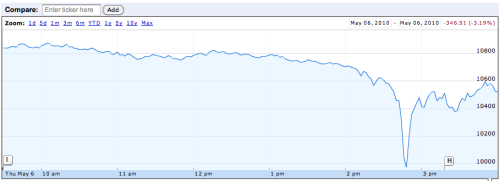So, unless you live under a rock, you heard that yesterday, at 2:45 pm, the stock market dropped like a rock:
 We don't know why this yet happened, but there are two likely culprits - and neither should make you happy.
We don't know why this yet happened, but there are two likely culprits - and neither should make you happy.
The first hypothesis is that this mini-crash was caused by 'fat fingers' - an errant trader entered $16 billion instead of million (this trader needs a dialing wand). Pause for a moment and think about that. Is this even possible? A trader can place a trade for $16 billion - larger than the GDP of 81 countries - without someone checking it? If this is even possible, then risk management is a joke and it's time to shut down some of these trading companies.
The other hypothesis is based on programmed trading. Massive automated trading means that Wall Street 2010 is part Skynet, where the machines are in control. It's possible that yesterday's downward spike was caused by a computer-controlled model gone wrong. It interpreted some combination of signals as meaning that the market was turning and it started to sell. Hard.
This sell order was then picked up by other machines who then started to sell too. And the feedback loop began, rocketing prices downwards.
At this point the sell orders come in faster than a human can make sense of them and you get panic on the exchange. Moreover, no market maker is able to stabilize the market because the trades are coming in faster than they can interpret them.
The irony is that another batch of computers are looking at the market and see this as a buying opportunity. Proctor and Gamble is down by 30%. A computer buys it because it knows that, due to mean reversion, it's unlikely that P&G will not gain back part of that loss very soon. And now the feedback loop kicks back in the opposite direction.
And the market stabilizes again, albeit down a few percentage points (which is a big deal).
If this turns out to be the reason for the spike, it's very disheartening. These programmed trading models are proprietary and we have no idea what they interpret as sell signals. It could be some combination of statistics and trading data; it could be as esoteric as reading blogs for sentiment. Moreover, even if 99% of models are 'correct', the 1% that wrong can potentially set off a cascade.
Moreover, the fact that the NASDAQ has cancelled all the wild trades yesterday reduces some of the incentive to fix the system. Don't get me wrong-whoever's system set this off is working the weekend to figure out what happened. But, a lot of people lost a lot of money yesterday (and some made a fortune too) and having those trades cancelled sends a signal that market owners are going to smooth these things over. If you get carried away, they'll just hit a big "undo" button (I wish I got this at my job).
The real reason this scares the living hell out of me, is that unpredictable volatility like this is typically a sign of a major instability in a complex system. Our financial system is a terribly complex system. When you see a major change like this, it's a sign that your models of the system are wrong and you're now flying the plane without a captain. I'm going on record as saying that no one on Wall Street really understands how the entire system works; the proof is in a thousand point decline -and 700 point rebound - in the span of 15 minutes. Statistically, this should never happen.
So what's going to happen? I'm putting my money on a huge increase in volatility over the coming months and, unless there's a change in the regulatory system (more disclosure of modeling, caps on trading limits or sudden price changes), increasingly shorter cycles of stability/volatility. It's going to be an interesting ride; hold on.